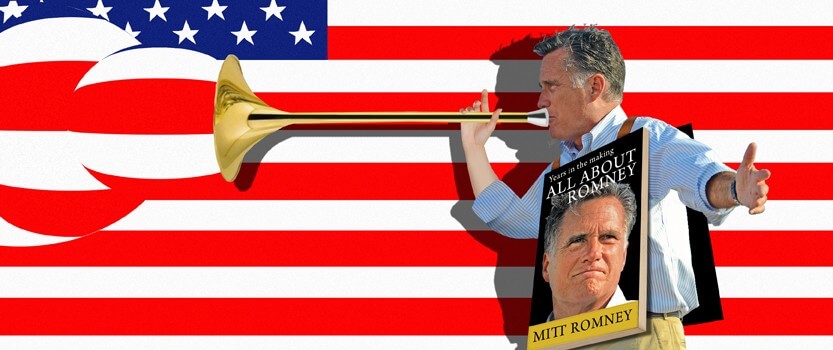
As we approach the end to this interminable election, let’s also bid farewell to that other political ritual – the politician’s book.
This article was made possible because of the generous support of DAME members. We urgently need your help to keep publishing. Will you contribute just $5 a month to support our journalism?
Forget the snappy scarf. In an election year, the accessory of choice for a political hopeful is a book, whether it’s red (like Mitt Romney’s No Apology) or blue (President Obama’s Audacity of Hope). Fast Company calls the nonfiction hardcover a cross between “the ultimate business card” and a mission statement for candidates. To be more direct: they’re propaganda. Extended campaign commercials in prose form. Trumpet solos by the power-hungry. And it is time – way past time – to call “time” on the politician’s book.
For starters, most political books are apparitions. It’s not merely that “the majority involve some sort of ghostwriter,” says Kirkus Reviews managing editor Eric Liebetrau. It’s that they have precious little actual content. We’re not going to get even an approximation of the truth until after these folks are done campaigning (Just compare Bill Clinton’s insubstantial Between Hope and History, written when he was up for reelection, with his candid post-presidential memoir, My Life).
Readers know this. And we’re not buying. Though Chris Schluep, senior editor of books at Amazon, points to a “slight uptick” in sales over the past few months, none of the candidates’ books are doing that great. Romney’s No Apology came out in paperback in February 2011, and according to Nielsen BookScan, has only sold 19,000 copies so far – less than a quarter of what Fifty Shades of Grey sold in one week in June. Paul Ryan’s Young Guns has done a paltry 14,000 since its Sept. 2010 paperback release. Joe Biden’s Promises To Keep has only sold 31,000 copies since it came out in 2008 and fewer than 1,000 this year. And while, yes, Obama’s books have significantly better numbers – his second (and less-well-reviewed outing) Audacity of Hope topped one million for the trade paperback that came out in Nov. 2007 – even he’s no longer on the New York Times bestseller list.
That’s not to say that there aren’t political books on the bestseller charts. There are. They’re just not the candidates’ books but those of their partisans – angry rants that stoke the fires of discontent rather than fostering understanding. In particular, says Liebetrau, there has been “a deluge of anti-Obama books.” Dinesh D’Souza’s Obama’s America, Edward Klein’s The Amateur, and Fool Me Twice, by Aaron Klein and Brenda J. Elliott are just a few that found footing on the New York Times bestseller list this September. But even they aren’t doing as well as they were before the conventions, says Schluep.
Typically, the books that do best preach to the converted – and the contentious. In August, Amazon has put together an Election Heat Map, dividing books into “blue” (Democrat leaning) and “red” (Republican) and monitoring daily sales. The chart started out glowing an angry red, although after a month, that early flush has evened out slightly, with 56% of sales going to red books and 44% to blue. But look at who is buying. In Democratic Massachusetts, 59 percent of political books purchased were blue last week. In Republican Texas, 65 percent were red. These readers don’t want their minds opened, they simply want their existing opinions confirmed.
Not that any of this is going to matter come November 7th. You may have John F. Kennedy’s Profiles in Courage on your bookshelf, but did you really keep that copy of Imposter: How George Bush Bankrupted America and Betrayed the Reagan Legacy? Not likely. Besides, four years from now, we’ll see another wave of books looking for an October bounce.
Once upon a time, political books might have made sense. Once upon a time, shoulder pads were a fresh look, too. In terms of publishing trends, however, books by – and about – politicians are a fashion whose time has passed.
Clea Simon is a critic and author, most recently of the mystery Grey Expectations. She can be reached at cleasimon.com.
Before you go, we hope you’ll consider supporting DAME’s journalism.
Today, just tiny number of corporations and billionaire owners are in control the news we watch and read. That influence shapes our culture and our understanding of the world. But at DAME, we serve as a counterbalance by doing things differently. We’re reader funded, which means our only agenda is to serve our readers. No both sides, no false equivalencies, no billionaire interests. Just our mission to publish the information and reporting that help you navigate the most complex issues we face.
But to keep publishing, stay independent and paywall free for all, we urgently need more support. During our Spring Membership drive, we hope you’ll join the community helping to build a more equitable media landscape with a monthly membership of just $5.00 per month or one-time gift in any amount.



















































































